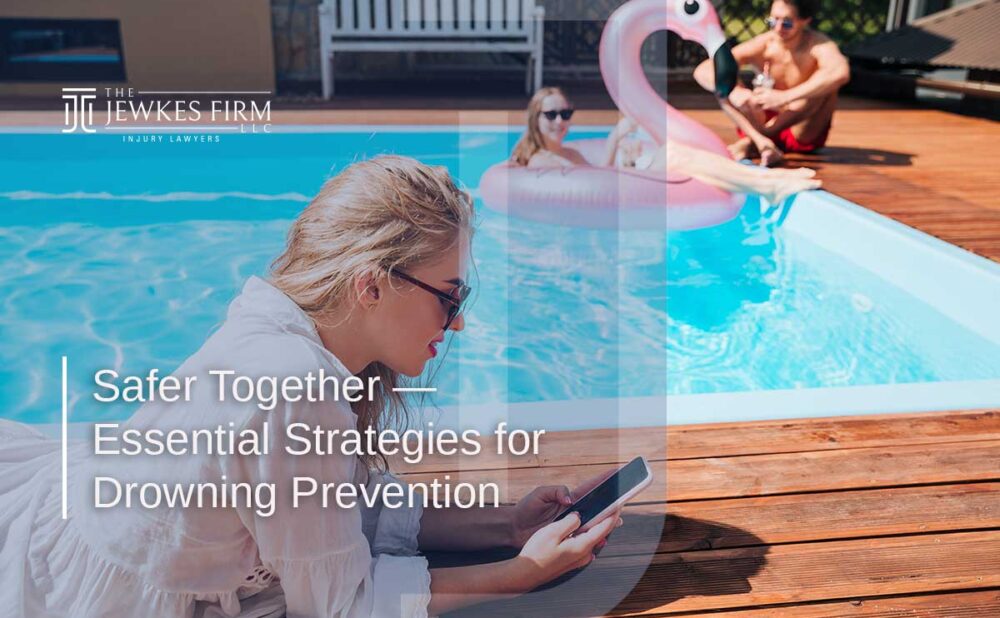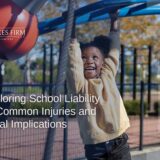Safer Together — Essential Strategies for Drowning Prevention
Every year, drowning impacts the lives of millions of people. Drowning is a leading cause of accidental death worldwide, and the impact permeates across families and communities. National Drowning Prevention Week (NDPW) is a vital initiative—created by The Lifesaving Society—that focuses on educating individuals about water safety and drowning prevention. The goal is simple: to prevent drownings and save lives. While water activities are associated with fun and leisure, it’s important to understand that they come with certain dangers. NDPW—observed annually the third week in July—runs from July 20-26, 2025. This year’s theme, “Safer Together,” emphasizes the collective responsibility of communities, families, and individuals in fostering safe environments around water.
As a personal injury law firm committed to serving our clients and the community, The Jewkes Firm understands the profound impact drowning incidents can have on families and society at large. We believe in spreading awareness of water safety practices, particularly in preventing accidents that can lead to life-changing injuries or fatalities. In this article, we will explore the various aspects of drowning prevention, including the risks involved, effective strategies to mitigate these risks, and the legal considerations surrounding drowning incidents.
Understanding Drowning Risks
Drowning is a silent and often overlooked tragedy that can affect anyone, regardless of age or swimming ability.
The recent drowning of Cosby star Malcom-Jamal Warner on a family vacation highlights how quickly and without warning drowning tragedies can happen. To effectively prevent drowning, it is crucial to understand the risks involved, the statistics surrounding this issue, and the common misconceptions that can lead to dangerous situations.
Fatal vs Non-Fatal Drowning
Drowning incidents fall into two categories: fatal and non-fatal. Fatal drowning results in death, while non-fatal drowning allows for survival, often leading to severe health complications such as brain injuries. Immediate administration of CPR and prompt medical attention are crucial for improving outcomes in non-fatal cases.
Understanding the Drowning Problem
Drowning is a leading cause of unintentional injury and death, particularly among children. According to the World Health Organization, an estimated 236,000 people drown each year worldwide, with many of these incidents occurring in recreational settings. According to the Centers for Disease Control and Prevention (CDC), drowning remains one of the leading causes of unintentional injury death for individuals aged 1 to 14 years.
In the United States, the statistics are sobering:
- Every day, an average of 10 people drown in the U.S.
- For every child who dies from drowning, another five receive emergency department care for non-fatal submersion injuries, which can lead to long-term disabilities.
- Approximately 4,000 fatal unintentional drownings occur annually.
- Around 8,000 non-fatal drownings occur each year, averaging 22 cases per day.
- Drowning is the leading cause of death for children ages 1–4 and the second leading cause of unintentional injury death for children ages 5–14, following motor vehicle accidents.
- Drowning is often silent; it can happen quickly and without warning.
These numbers highlight the urgent need for awareness and preventive measures.
Common Misconceptions About Drowning
Despite these alarming statistics, many people hold misconceptions about drowning that can lead to a false sense of security. One prevalent myth is that drowning is a noisy and chaotic event. In reality, drowning iusually happens quietly, with victims unable to call for help or splash for attention, making it difficult for bystanders to recognize when someone is in danger.
Another misconception is that individuals who are good swimmers are immune to drowning. Sadly, even experienced swimmers can find themselves in perilous situations, particularly when facing fatigue, unexpected currents, or medical emergencies. This underscores the importance of vigilance and constant supervision around water, regardless of one’s swimming proficiency.
High-Risk Groups and Environments
Certain groups of people are at a higher risk of drowning. Young children, especially those aged 1 to 4, are particularly vulnerable, as they often lack the ability to recognize danger and may wander unsupervised near water. Additionally, adolescents and young adults, particularly males, have higher drowning rates, often due to risky behaviors such as swimming under the influence of alcohol or engaging in dangerous water activities.
Various environments also pose significant risks for drowning incidents. Residential pools, lakes, rivers, and oceans each present unique challenges. For example, natural bodies of water can have unpredictable currents and depths, while home pools may lack adequate safety measures such as fencing and supervision. Understanding these high-risk groups and environments is essential for implementing effective drowning prevention strategies.
By recognizing the statistics, debunking common myths, and identifying vulnerable populations and risky environments, we can begin to take meaningful steps toward preventing drowning incidents.
The Importance of Water Safety
Water activities are a popular pastime for many families, particularly during the hot summer months. However, along with the enjoyment comes the very real danger of drowning. As an injury firm that has represented numerous clients involved in accidents, The Jewkes Law Firm understands the profound emotional and physical toll that these incidents have on families. Drowning incidents, especially those that involve children, are particularly devastating. It’s essential to understand that drowning can happen in seconds, even in shallow water or under seemingly safe conditions.
Impacted by a Drowning Injury or Loss? Contact Us For A Free Consultation
Impacted by a Drowning Injury or Loss?

Effective Drowning Prevention Tips
Drowning is a preventable tragedy, and adopting effective strategies can significantly reduce the risks associated with water activities. As we focus on the theme of “Safer Together” during National Drowning Prevention Week (NDPW), it is vital to understand the proactive measures we can implement to protect ourselves, our families, and our communities. Below are several key strategies that can help ensure safer water experiences:
Importance of Swim Education and Training
One of the most effective ways to prevent drowning is through proper swim education and training. Everyone, especially children, should learn how to swim. Basic swimming skills include learning to roll into the water, treading water for at least one minute, and swimming a distance of 50 meters to reach safety. Learning how to swim is a fundamental life skill that not only enhances water confidence but also plays a vital role in drowning prevention. Many local community centers offer swim lessons for people of all ages. Swimming lessons increase confidence and reduce the likelihood of drowning by helping individuals understand their abilities and limitations in the water.
Supervise, Supervise, Supervise
Never leave children unattended near any body of water, whether it’s a pool, lake, or bathtub. Drowning incidents can occur in mere seconds. It is crucial to remain within arm’s reach of young children whenever they are near water and to maintain unwavering focus on their activities. Designate a Water Watcher to ensure constant supervision. Even adults should swim in designated areas and avoid distractions like cell phones.
Avoid Alcohol and Water Activities
Alcohol impairs judgment, balance, and coordination, making drowning more likely. Avoid drinking alcohol when swimming or participating in water sports. Awareness of this connection is essential for safety during water-related activities.
Respect Water Conditions
Natural water bodies like lakes, rivers, and oceans present unique challenges. It’s vital to understand specific risks, monitor environmental conditions, and avoid swimming alone to enhance safety during aquatic activities. Always check water conditions before entering. Stay informed about local weather, currents, tides, and potential risks, especially if you’re swimming in the ocean or a natural body of water.
Use Lifejackets and Proper Safety Gear
Utilizing safety equipment is another critical component of drowning prevention. Life jackets should be mandatory for boating, fishing, or engaging in any water activity, especially for those who are not strong swimmers. It is essential to ensure that life jackets are appropriately fitted and approved by safety standards. In addition to life jackets, other safety devices, like personal flotation devices (PFDs) and buoyancy aids, should be readily available.
Ensure Pool Safety
If you have a private pool, make sure it has a fence with a self-closing, self-latching gate to prevent unauthorized access. This will help keep kids and others from getting in without permission. Ensure pool areas have rescue equipment like reaching poles and life rings, and that everyone knows where they are.
Technology also plays a vital role in enhancing water safety. Innovations like pool alarms, which alert caregivers if someone enters the water unexpectedly, can be invaluable. Additionally, drowning detection systems, which utilize sensors to monitor water activity, are becoming more prevalent. Families and communities should stay informed about the latest safety technologies to help mitigate drowning risks effectively.
Know CPR and First Aid
Knowing CPR (Cardiopulmonary Resuscitation) and basic first aid can be life-saving in an emergency. Sign up for a CPR class so you are ready for any possible drowning emergencies. Quick action, like performing CPR, can greatly increase the chances of survival until medical help arrives.

Legal Considerations and Responsibilities
Drowning incidents can have devastating consequences, not only for the victims and their families but also for those who may be held legally responsible. Understanding the legal landscape surrounding drowning cases is crucial for both prevention and accountability.
Liability Issues in Drowning Cases
When a drowning occurs, various parties may be implicated in a legal context. Liability can arise from negligence, defined as the failure to exercise reasonable care, leading to harm. Property owners, whether residential or commercial, have a duty to ensure that pools or water bodies on their premises are safe and secure. This includes maintaining proper safety barriers, providing adequate warnings, and ensuring supervision, especially in areas where children may be present.
In addition to property owners, other parties may hold liability as well. Lifeguards, swim instructors, and even event organizers could be found negligent if they fail to uphold safety standards or protocols. Understanding who holds responsibility in these situations is essential, as it can directly impact the compensation available to victims and their families.
How Personal Injury Law Applies to Drowning Incidents
Personal injury law plays a significant role in drowning cases. Victims or their families may seek compensation for medical expenses, emotional distress, and loss of income resulting from a drowning incident. To establish a successful claim, it is vital to prove that another party’s negligence directly contributed to the drowning. This process often involves gathering evidence, including witness statements, accident reports, and expert testimonies.
In cases where a drowning occurs due to defective equipment, such as faulty pool drains or inadequate safety devices, product liability may also come into play. Attorneys specializing in personal injury law can help navigate these complex cases, ensuring that victims receive the justice they deserve.
Resources for Legal Support and Guidance
For families affected by drowning incidents, seeking legal support can be a daunting task. It is essential to consult with an attorney experienced in personal injury law who understands the intricacies of drowning cases. Legal professionals can provide guidance on the best course of action, help gather necessary documentation, and represent victims in negotiations or court proceedings.
Additionally, organizations such as the American Red Cross and the National Drowning Prevention Alliance offer resources and information on drowning prevention, safety measures, and legal considerations. These resources can empower individuals and families to make informed decisions while advocating for safer practices in their communities.
What Can You Do to Make a Difference?
As individuals, we all have a role to play in preventing drowning. Here are some ways you can participate during National Drowning Prevention Week and beyond:
- Spread Awareness – Share information about water safety on your social media, at community events, or within your family. Use the hashtag #SaferTogether to spread the message.
- Get Involved Locally – Participate in local events or programs that focus on drowning prevention. Volunteer with organizations that teach water safety and offer swimming lessons.
- Talk to Your Family – Have conversations with your loved ones about water safety practices. Make sure everyone understands the importance of supervision and wearing safety equipment.
- Support Safety Regulations – Advocate for laws and regulations that promote water safety, such as mandatory lifejackets for boating or stricter pool safety standards.
- Contact a Personal Injury Attorney – If you or someone you know has been involved in a drowning incident, it’s important to understand your legal rights. A personal injury attorney can help navigate the complex legal landscape surrounding such incidents.
Drowning is a preventable tragedy that affects far too many families each year. By raising awareness, educating others, and practicing proper water safety, we can reduce the risks and prevent future incidents. During National Drowning Prevention Week (July 20-26, 2025), let’s all come together to ensure that everyone is safer in and around water.
Remember, safety is a shared responsibility.
The Importance of Collaboration in Drowning Prevention
At The Jewkes Firm, we believe that legal advocacy is just one piece of the puzzle. We support drowning prevention initiatives and collaborating with others to create safer spaces for families to enjoy water activities. As a law firm committed to advocating for the rights of victims and their families, The Jewkes Firm is here to help if you or a loved one has suffered a drowning-related injury or loss.
Drowning can have devastating consequences, and the emotional and financial impact on families can be overwhelming. We offer compassionate legal support and will fight for justice on your behalf. If you or someone you know has been affected by a drowning accident, contact The Jewkes Firm today at (770) 771-5130 to schedule a free consultation.
For more information on drowning prevention and resources available in your area, please visit the Lifesaving Society’s website or contact us at The Jewkes Firm. Together, we can make a difference!

GEORGIA PERSONAL INJURY LAWYER NEAR ME
Frequently Asked Questions
What is National Drowning Prevention Week (NDPW)?
National Drowning Prevention Week (NDPW) is a designated week by The Lifesaving Society to raise awareness about drowning risks and to promote water safety practices. It takes place every year in the third week of July. In 2025, NDPW will occur from July 20-26, with the theme "Safer Together."
Why is drowning prevention important?
Drowning is a leading cause of unintentional injury and death, especially among children. Raising awareness and promoting safety measures can significantly reduce the risk of drowning incidents.
How can I prevent drowning accidents?
To prevent drowning, always supervise children around water, ensure everyone knows how to swim, wear lifejackets while boating, and follow all water safety guidelines. Learn CPR and know the risks in different water environments.
Can I volunteer or get involved during National Drowning Prevention Week?
Yes! You can help by sharing water safety tips, participating in local events, and advocating for drowning prevention measures in your community. Visit The Lifesaving Society or other organizations to learn about volunteer opportunities.





